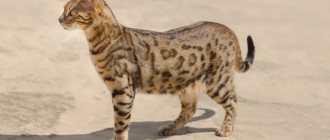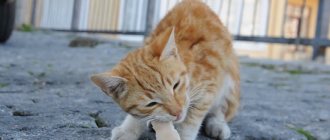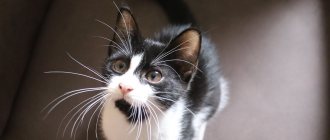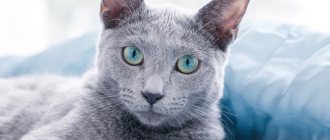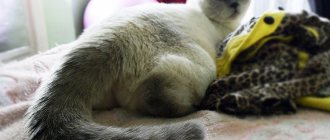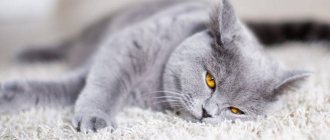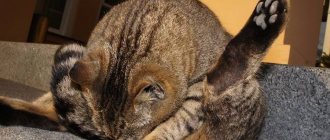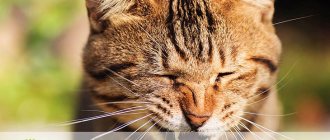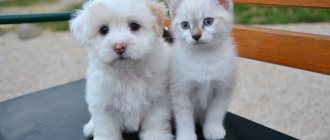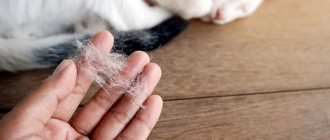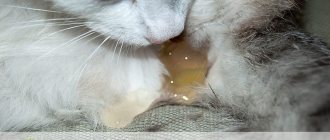Determination of the degree of fatness
You should not talk about weight loss without first determining whether the animal has really lost weight. This is done as follows:
- The first and most common sign of exhaustion is “fence” ribs. This means that the ribs protrude strongly from under the skin, and therefore can be easily felt even after a light touch, not to mention palpation.
- When you palpate the base of the tail, you can feel its “bone” structure; you can easily find the sacral bone and the first caudal vertebrae.
- If you look at a cat from above, it is easy to notice that its figure is very similar to an hourglass. However, their back part will be greatly narrowed, while the back of the animal is clearly pointed, it is awl-shaped.
- When palpating the paws (especially the front ones), even an inexperienced person can determine the shape and structure of the bones. Simply put, the limbs resemble pieces of a skeleton covered in skin. The muscles are flabby and jelly-like to the touch.
Pathological reasons for a cat losing weight
A sudden change in your pet's appetite without reason is a bad sign. Gastrointestinal diseases, oncology or parasites cause terrible suffering to the cat. Without the intervention of specialists, the animal will die. Main pathologies requiring consultation with a doctor:
- Thinness is often caused by helminthiasis, that is, infection with worms. It occurs through dirty water, during communication between animals, through dirty objects, the hands of the owner, and also from cats to kittens.
- Cancerous tumors are a common cause of weight loss. The pet suffers, but does not have the opportunity to say about it. Unfortunately, many owners do not pay attention to their pet’s mood changes for a long time, so cancer is diagnosed too late.
- Many diseases of the digestive system initially manifest themselves as a change in preferences or a complete refusal of food by the cat. For example, pancreatitis.
Causes of weight loss
Weight loss in a pet can be caused by a variety of factors. Experienced breeders most often cite non-compliance with feeding standards, the use of low-quality feed and an unbalanced diet among the reasons leading to malnutrition. Often the reason for a small weight is a discrepancy between the food and the pet’s taste preferences.
Causes of cat thinness
Rationale
Exhaustion of the animal after giving birth and feeding the offspring
Often it is mother cats who upset their owners with exhaustion, especially if there are many kittens in the litter. As a rule, after weaning the babies, the animal regains its normal weight;
The period of sexual hunting
Owners most often encounter this phenomenon in the spring. During the period of activation of sex hormones, both females and males lose weight.
Stress
This is one of the factors due to which a cat can lose kilograms and become very thin in a short period of time. Moving, changing ownership, or adding a new family member or pet to the house often leads to significant weight loss in a cat.
The owner often observes that the cat has a good appetite, but does not gain weight, and the animal is exhausted. Helminths feed on ready-made nutrients, creating their deficiency in the cat’s body. In addition, waste products of worms lead to general intoxication and deterioration of the pet’s condition.
Dental condition
Caries, tartar, inflammatory processes in the oral cavity, and gum disease complicate the normal process of grasping food, causing discomfort and pain. The cat's appetite decreases, sometimes it completely refuses to eat.
Age
Older pets tend to sleep a lot, exercise less and eat less food. The presence of numerous chronic diseases and dental problems contribute to thinness in old cats.
Lack of vitamins and mineral elements
accompanied by poor weight gain. This is due to a slowdown in the synthesis of muscle mass and disruption of biochemical processes in the body.
Chronic illness
The pathological process can be localized in the kidneys, liver, gastrointestinal tract
The cause of exhaustion is often a dysfunction of the thyroid gland. If your cat is very thin, what can you do to get it in shape? When feeding natural products, attention should be paid not only to the quantity, but also to the quality of the products. First of all, the animal’s diet should contain meat.
Preference should be given to lean beef and turkey. The share of meat in the diet should be at least 50%. For normal digestion, you should definitely give your cat vegetables: carrots, pumpkin, turnips. The source of carbohydrates necessary for fattening the animal are cereals, which contain buckwheat and rice groats. We recommend reading about. You will learn about the benefits of feeding on a schedule, whether you should leave food on a cat’s plate, determining whether you are obese or malnourished by weight, and examples of the optimal menu. Learn more about how to feed a kitten without a cat. Mistakes while feeding
Experienced breeders and veterinarians note the following feeding errors that lead to weight loss in a cat:
Small portions of food that do not meet the physiological needs of the animal. Some owners do not take into account the breed, age and gender of the animal when feeding.
An unbalanced diet or its inconsistency with the pet’s needs. For example, chronic protein deficiency sooner or later leads to thinness.
Feeding without taking into account the animal's taste preferences. Cats are great conservatives, especially when it comes to food. If your pet wants to eat dry food and refuses to eat natural food, then you should feed it with ready-made food.
Incorrect placement of the food bowl. Close proximity to the toilet, placement in a noisy and walk-through room do not contribute to a good appetite. For the basic principles of feeding cats, watch this video:
Knowing the numerous causes of weight loss in a pet, the owner will sound the alarm in time. After the veterinarian has ruled out infectious diseases and other serious pathologies in the pet, attention should be paid to proper nutrition of the animal.
Why is the cat skinny?
A cat may look thin for completely natural reasons. In most cases, with a good appetite, the animal soon begins to recover and returns to normal. Natural (physiological) reasons include :
- Feeding offspring - the thinness of a cat during the period of feeding kittens should not be a cause for concern. The female will recover after the cubs switch to regular cat food.
- Mating period - during the mating season, cats tend to lack appetite due to hormonal stress. This is especially true for animals accustomed to walking on their own.
- Stress – Cats can become stressed in certain situations. At the same time, the animal loses weight because it eats little or refuses food. The reason may be a move, a change of owner, or the arrival of a child, another cat or dog in the house.
- Changing food - if a cat is offered a new food, he may eat it less or refuse the treat altogether. If over time the animal does not adapt, it is necessary to return to its usual diet.
- Age – If the pet is young, overly active, often plays and moves a lot, weight loss is considered a natural consequence. Older cats also tend to become thinner as the body stops storing fat. In this case, it is necessary to visit a veterinarian to rule out diseases.
- Parasites – helminths – are a very common cause of pet thinness. Helminthic infestation disrupts the animal's digestive processes. And the waste products of parasites lead to intoxication of the body. Therefore, it is important to give your cat anthelmintic drugs on time.
- Infectious diseases - diseases such as calcevirosis, panleukopenia, viral peritonitis and rhinotracheitis are accompanied by dehydration and lack of appetite. Symptoms: discharge from the nose and eyes, diarrhea, high fever. If these signs appear, you should immediately contact a veterinarian. Lack of timely treatment can lead to death.
- Oncology – the presence of malignant tumors can also cause exhaustion. If a tumor is suspected, the veterinarian will prescribe an ultrasound.
- Teeth and gums – it happens that a cat cannot eat for dental reasons. If an animal is interested in food, but cannot eat, it is necessary to show it to a specialist.
- Other diseases – almost any disease can lead to weight loss. A cat loses weight if it has problems with the kidneys, liver, heart, thyroid gland, metabolic disorders, or viral diseases. An accurate diagnosis can only be made by a qualified specialist.
Physiological reasons do not cause concern, but you can pay attention to the animal’s diet - whether it is healthy and nutritious enough.
© shutterstock
It’s bad if the cat shows signs of exhaustion, this indicates the presence of diseases. If the cat has lost a lot of weight, most likely the reason lies in one of the pathologies :
Any of the pathologies requires immediate veterinary intervention. Only a veterinarian can determine why a cat is thin and prescribe the necessary treatment. A preventive visit to the clinic once a year is also recommended to check the general health of the animal.
Prevention
The owner must provide the pet with good and proper nutrition, carefully monitoring the regime and diet, and the availability of clean drinking water. A starving cat loses its beauty, becomes embittered and sick. Cheap food or table food leads to problems with the pet’s teeth and the entire digestive system.
It is important to remember about vaccinations. Many people naively believe that if an animal lives in an apartment, it will not get sick.
Viruses and infections can be carried on clothes and shoes, and a domestic cat is much more susceptible to them than an outdoor cat.
A pet walking on its own should be checked for ticks in the spring and autumn, as they not only cause pain, but also carry various viral diseases.
If any change of situation is planned (the appearance of children, new pets, moving), the owner should be near the animal more often. Everything new should be introduced gradually, giving your pet space and time to adapt.
Stressful state
Very often, cat owners are faced with the problem that their animals lose weight. This may occur due to the fact that when the animal is stressed, it loses its appetite. Stressful conditions for an animal can be the following:
- Moving.
- Arrival of relatives.
- Change of owners.
- Birth of children.
- New pet in the house.
In this case, the animal must be fed as before and it is advisable to use the same dishes in which the animal was fed previously. In addition, the cat should be fed by a person who has done this before. If everything is returned to its original place, the animal’s appetite may be restored and it will begin to gain weight again.
What the owner should know!
The cat must be weighed periodically.
Owners of cats and cats should carefully study the behavior of their pet. As for the weight of the animal, it should be checked in accordance with the characteristics of the breed and age of the animal. There are small deviations from the norm that do not pose a danger .
If, for unknown reasons, your pet has lost a lot of weight, he often has no appetite, and the quality of his stool and urine has changed, then this is a reason to contact a veterinarian. With a normal diet and severe weight loss, a common cause is helminths, which need to be gotten rid of immediately. If the disease is not advanced, then treatment can be undertaken at home. Medicines (drops, tablets) will help get rid of parasites.
To help your cat maintain weight, try to feed it 2-3 times a day, feed it in normal doses, give it balanced and varied food, and provide clean water.
Carry out worm prevention every six months, and also keep the house clean and thoroughly wash the cat's litter box.
Treatment
Depending on the diagnosis, malnourished animals may be advised to:
- Antibiotic therapy, treatment for worms, antibacterial drugs - for inflammatory or parasitic intestinal diseases.
- High-calorie quality diet.
- In some cases, force feeding or feeding through a tube.
- Parenteral (intravenous) nutrition – for cats unable to eat due to vomiting or regurgitation, illness.
- Surgical treatment is the removal of large tumors or foreign bodies from the intestine.
Treatment of renal and liver failure, maintenance therapy.
Due to the fact that there are many reasons for refusing to eat, only a qualified specialist can make an accurate diagnosis based on laboratory and clinical studies. The animal undergoes a thorough clinical examination, including auscultation and palpation, as well as thermometry. Next, the doctor prescribes:
- general blood analysis;
- blood chemistry;
- coprogram;
- X-ray of the chest and abdominal organs.
After determining the reason why the cat began to lose weight and lost interest in food, the veterinarian develops a treatment regimen depending on the age, weight and breed of the cat.
First of all, it is necessary to eliminate the cause that caused the changes in the body. If the cause is the accumulation of hairballs in the stomach, special pastes are prescribed that contain substances that promote the passage of hairballs through the digestive tract.
Refusal to eat due to sexual desire cannot be treated. Manifestations of this kind can be prevented by sterilizing an animal that does not have breeding value. In addition, timely sterilization of a cat allows you to protect your pet from the development of other serious diseases that occur against the background of hormonal imbalances (ovarian cancer, uterine cancer, or pyometra).
It is also important to strengthen the overall immune forces of the body. To maintain your cat’s health at the proper level, it is necessary to provide high-quality food and vitamin supplements.
In order to prevent diseases such as rabies, canine distemper, infectious peritonitis, it is important to carry out immunization according to the vaccination calendar. If your animal exhibits symptoms of ill health (lethargy, aggression, refusal to eat), it is necessary to contact a veterinarian as soon as possible to make an accurate diagnosis.
The main treatment is prescribed by a veterinarian based on the results of the diagnosis and tests, since it is specific for each disease. The chosen therapy is aimed at eliminating not only the symptoms, but also the cause that caused the malaise and, as a consequence, refusal to eat with subsequent weight loss.
It is necessary to carefully monitor the cat's condition, as this will allow you to verify the presence or absence of symptoms. You can warm up the food a little (canned meat), so its smell will be stronger
It is important that it is not very hot
Why does a cat eat poorly and lose weight?
Throughout their lives, cats may lose interest in food for periods of time. There are several reasons why a cat eats poorly and loses weight. This behavior in a pet may be associated with a behavioral disorder or physiological characteristics.
In some cases, loss of appetite indicates serious diseases of the internal organs caused by chronic illnesses or infections. Reasons not related to diseases, but causing loss of appetite in a cat, may be the following:
- The period of estrus and puberty . As a result of a strong hormonal surge, the pet's behavior changes dramatically - the cat shows aggression and becomes overly excited. Temporary anorexia during this period is not a pathology and should not cause concern to the owner. Without planning to have offspring from your furry pet in the future, veterinary experts recommend routine sterilization. Thus, it will be possible to avoid not only manifestations of sexual desire, but many related problems.
- Accumulation of hairballs in the stomach . The reason that a cat is losing weight and also eating little may be hairballs - trichobezoars - that have accumulated in the stomach. Under normal conditions, excess hair passes through the intestinal tract and is excreted in the feces. If the hairballs are too large, your pet cannot regurgitate them and the stomach becomes clogged and stretched. As a result of this, the cat eats little and loses weight, the animal retains stool, and the fur becomes unkempt.
- Stressful conditions of the animal . It happens that the animal looks absolutely healthy, its behavior does not change, except for refusing food. The reasons may be hidden in the psycho-emotional state of the pet. Stress in a cat can occur due to the appearance of another animal in the house or a small child, as well as during moving, punishment or after quarrels between animal owners.
- Feeding irregularities . Quite often, cat owners make the mistake of suddenly switching their pet to a new food. This may cause you to refuse food. To avoid this behavior in a cat, veterinarians recommend accustoming or switching the animal to a new type of food gradually. Feed must be fresh, without violations in storage technology. Cats refuse to eat spoiled food, as they naturally have a highly developed sense of smell.
- Age problems . Old cats become picky eaters, they are more likely to experience loss of appetite and associated weight loss. After the age of six, changes occur in the animal’s body and the process of assimilation of food changes. In addition, animals at an advanced age are often diagnosed with diseases of the teeth and gums. Inflammatory processes in the oral cavity lead to the fact that the animal tries to eat less, the cat loses weight and looks quite exhausted. The owner of an old animal is recommended to contact a veterinarian and consult about the selection of a new diet. Older cats prefer wet and soft food.
- Foreign objects in the mouth . When sharp objects eaten by a cat (bones, chips, blades of grass) become stuck, the animal refuses to feed due to the onset of the inflammatory process and severe pain. Foreign objects are especially often found in a kitten’s mouth, because due to their curiosity, babies try to taste everything. The pet looks hungry, meows pitifully, but at the same time cannot fully absorb food. This provokes weight loss and lethargy of the animal. It is important to promptly contact a veterinarian for assistance.
There are a number of diseases that affect the disturbance of appetite in an animal. Thus, various helminthiases and dangerous infectious diseases provoke the appearance of many symptoms, including nutritional disorders. Cats with helminth infections not only lose interest in food, but they may develop a perversion of taste preferences.
Among the infectious diseases that can cause a cat to refuse to eat are the following:
- Rabies . A dangerous disease characterized by refusal of food and severe depression of the animal’s general condition in the first stages. With the development of symptoms, hypersalivation, clouding of the cornea of the eye, exhaustion, eruption of gastric contents, and diarrhea with blood appear.
- Plague . An infectious disease that provokes an increase in body temperature to high levels, a sharp refusal to eat food and water, the appearance of vomiting and diarrhea.
- Leukemia virus. Against the background of a general weakening of the body’s immune forces, the cat develops inflammatory processes in the oral cavity (stomatitis, gingivitis), the functioning of the digestive system is disrupted, the body temperature rises, and the lymph nodes enlarge. The pet refuses to eat, loses weight sharply and loses interest in what is happening around.
- Viral enteritis . They cause disturbances in the gastrointestinal tract, causing profuse vomiting and diarrhea with mucus and blood. The cat refuses not only food, but also water. Dehydration develops quite quickly, the cat loses strength and may die without medical intervention.
Loss of appetite is also caused by disorders of the internal systems of the body that are not associated with infectious agents. Thus, the cause of loss of appetite and sudden weight loss in a cat may be diseases of the hepatorenal system (lipidosis, urolithiasis), diabetes mellitus, inflammatory processes in the intestines of an idiopathic nature.
One of the reasons for refusing food is cat poisoning. Intoxication of the body can occur as a result of a cat eating poisonous plants or poor-quality food. In addition, household chemicals and zoocoumarins (substances used to bait rodents) can cause poisoning. All types of poisoning, even medicinal ones, are accompanied by a refusal of food and a general state of lethargy in the cat.
Signs of an Aging Cat
Some cats begin to show physical signs associated with aging as early as seven years of age, while others are as playful as kittens at ten years of age. Generally, a cat is considered “senior” if it is over 11 years old.
If you are the owner of an older cat, you need to watch for changes in his behavior that may indicate an underlying problem. Here are six of the most common symptoms and illnesses you may notice in your aging pet:
- Sleeping all the time... or not sleeping at all While it's normal for cats to slow down as they age, sleep disturbances can indicate more serious health problems. If you notice that your cat is constantly sleeping and sleeping deeper than usual, or, conversely, is becoming more active at night, this may indicate age-related changes. Tree House Humane Society in Chicago also notes that an older male or female cat that suddenly has a lot more energy may be suffering from hyperthyroidism. If you have any doubts about the general health of your pet, please consult a veterinarian.
- Confusion If your cat becomes confused by common tasks or objects she is used to navigating through, such as having trouble finding her bed, she may be approaching her golden years. This can also be a sign of cognitive problems, so if you notice this behavior in your pet, you should contact your veterinarian.
- Problems climbing stairs or jumping Arthritis is common in older cats. Although she may not limp or show other obvious signs of joint problems, she may find it increasingly difficult to jump into the litter box, climb stairs, or climb on furniture.
- Unintentional weight loss or gain According to the University of Illinois School of Veterinary Medicine, weight loss in an older cat can be a sign of health problems ranging from heart and kidney disease to diabetes. Some pets' food and energy needs may increase as they age, and cats may lose weight faster than they replace it with food. On the other hand, as cats age, their metabolism slows down, so they don't need as many calories as they used to. If you notice that your cat is starting to gain weight, it may be worth switching to a senior cat food that is better suited to meet her biological needs.
- Behavioral Changes Is your pet experiencing involuntary urination that never happened before? Does she avoid human contact? This could be a symptom of kidney failure, but it could also be a sign that she is in pain or has a mental disorder, conditions that are most common in older cats. A veterinarian will help you understand your pet's behavioral changes.
- Dull or oily coat A cat that has stopped grooming itself may be in pain due to arthritis or dental problems.
Older cats should be seen by a veterinarian every six months. But if you notice any changes in your pet’s behavior or appearance, you shouldn’t hesitate and it’s better to immediately visit a veterinarian who knows all the signs of aging in cats.
Reasons for losing weight with a good appetite
Here are some of the most common causes of weight loss in cats who still eat a lot. If your cat is constantly pestering for food but seems underweight, here are some of the reasons why:
Hyperthyroidism
This condition is commonly seen in older cats and is perhaps the most obvious example of a skinny, hungry cat. These cats can often lose a lot of weight but still have an overly keen appetite. Other symptoms such as stomach upset, changes in temperament/activity, increased thirst, and increased heart rate are sometimes observed.
Hyperthyroidism is caused by increased production of thyroxine, a hormone that controls metabolism. This occurs because the thyroid gland is growing - usually benign, but in very rare cases a malignant tumor (thyroid adenocarcinoma) can be the cause of these symptoms.
Diagnosis is usually made based on a physical examination and blood tests. Your veterinarian may suspect this condition after examining your cat. Sometimes they may feel an enlarged gland in the throat and hear abnormalities in the heart, such as increased heart rate and changes in rhythm. To screen for other diseases and determine your cat's thyroxine levels (called T4), a blood test is recommended.
© shutterstock
If your cat is diagnosed with hyperthyroidism, there are several treatment options.
- Medications – Taking a daily tablet or liquid may help suppress your cat's thyroid hormone production and control symptoms. She will need regular monitoring with exams and blood tests.
- Surgery – Removal of the thyroid gland can be curative, meaning without ongoing treatment. However, there are some risks associated with this.
- Diet – A prescription diet with limited iodine levels may prevent your cat from producing thyroid hormone. This doesn't mean you can't use treats or other foods because the diet won't work. It's also not very tasty, and some cats won't eat it.
- Radioiodine therapy is considered the “gold standard” and is a curative treatment in most cases. Radioiodine therapy for cats involves a stay in a specialized hospital for several days. After this, no ongoing monitoring will be required, but it can be expensive and may not be suitable for some cats.
Hyperthyroidism can be treated in many cats, providing a good quality of life once diagnosed. If left untreated, your cat may suffer from high blood pressure (leading to eye problems), digestive problems, and heart abnormalities. Untreated hyperthyroidism can ultimately be fatal within a few months.
Diabetes
Diabetes mellitus (diabetes mellitus) can cause cats to lose weight. They will also have increased thirst and urination more frequently, and some of these cats will have an increased appetite (called "polyphagia").
Diabetes is caused by a reduced ability to produce insulin, the hormone that controls blood sugar levels. It may be a type I autoimmune disease (common in humans but rare in cats) or type II, caused by abnormalities of the pancreas as well as insulin resistance in the body's tissues. This is much more common in overweight cats who are not very active.
Diagnosis is usually made after a physical examination and blood tests that show high glucose (sugar) levels. Urine samples can also be helpful as high glucose levels can often be found here as well.
Treatment often involves adding insulin to the cat, which is done through regular daily injections. In some cases, dietary nutrition can be very helpful. Improperly treating diabetes can lead to complications such as problems with your cat's nervous system, vision problems, and a serious condition called ketoacidosis, which can be fatal.
Inappropriate diet
Your cat's weight loss may be caused by an inappropriate diet, such as an energy imbalance. This can happen if a very energetic cat doesn't get enough food. Make sure you double check that the food packaging recommendations match your cat's ideal weight. Also keep in mind that some cats will need a little more than recommended (if they are very active) and equally some will need a little less.
Make sure your cat is on a nutritious, good quality diet appropriate for her life stage (kitten, adult, senior). Preparing food at home can be very difficult and will require advice from a registered veterinary nutritionist.
Parasites
A large number of parasites can cause weight loss. Worms, such as roundworms and tapeworms, that live in your cat's digestive tract can absorb some of the nutrients your cat eats, causing her to lose weight.
Cats infected with parasites may also exhibit other symptoms such as diarrhea or vomiting. To prevent this from happening, make sure your cat is regularly treated for worms, especially if she hunts or spends a lot of time outside.
© shutterstock
Stress
Some cats may eat more due to stress, but they may also burn it off due to nervous energy. Stress-related vomiting may mean they stop eating the food they eat.
Other signs of stress in cats include hiding more than usual, accidents in the house (urine and feces), and changes in temperament. Cats can become stressed by things like moving, a new baby in the house, new pets moving into the house, and new cats in the neighborhood outside. Before attributing a cat's underweight to stress, it is important to rule out other health problems.
Diseases of the gastrointestinal tract
There are a variety of digestive disorders that can mean that your cat still has a keen appetite but is unable to digest food properly. Conditions such as inflammatory bowel disease and some types of cancer may cause vomiting or diarrhea. This can lead to weight loss because your cat cannot digest food efficiently. If your cat is showing signs of poor digestion, you should seek advice from your veterinarian.
Cases of diseases and their symptoms
Older pets suffer from a wide range of illnesses. Here are some of them:
Diabetes
Have you noticed that your cat is drinking more and urinating more often? Has your pet started to lose weight, but still eats its usual portion or has its appetite increased? These symptoms may indicate that your cat has diabetes or problems with the thyroid gland (hyperthyroidism).
Kidney problems in cats
If kidney problems occur in older cats, they may have similar symptoms, but they will be accompanied by poor appetite or a complete absence of it. It is not at all necessary that these symptoms will appear suddenly. Often, symptoms are likely to be quite mild in the early stages of the disease and will develop gradually over several months before you realize that your pet has a problem, and this is not just age-related changes and it is time to contact a veterinarian.
In case of late calls (often the animal is already excessively exhausted and has not eaten for a long time), doctors have to prescribe supportive or palliative therapy, since there is no other way out. This mainly applies to those animals diagnosed with chronic renal failure, treatment of which is more effective in the early stages of the disease.
I would also like to draw the attention of owners who attribute their pets’ poor appetite to dental problems (tartar, gingivitis, periodontal disease) to the fact that it is extremely undesirable to carry out sanitation on a cat under general anesthesia without first examining the animal (biochemistry and general blood and urine tests , ultrasound of the abdominal cavity, etc.). Without these tests, you can end up with clean teeth in your pet, but end-stage renal failure
Without these tests, you can end up with clean teeth in your pet, but end-stage renal failure.
Problems of "fat people"
For elderly cats and cats who are obese, there is a fairly high risk of developing lipidosis, which clinically manifests itself with sudden weight loss and temporary starvation. External symptoms of this disease are changed color of urine, yellowness of the mucous membranes and skin, lethargic and depressed state of the animal, the cat is capricious or completely refuses to eat.
Reproductive system
For unsterilized cats at this age, there is a high risk of diseases of the reproductive system - endometritis/pyometra (purulent inflammation of the uterus). Its main symptoms:
- Lethargy;
- Oppression;
- Partial or complete refusal of the cat to eat;
- Purulent or hemorrhagic discharge from the genital tract.
In the closed stage (large) pyometra, there may be no discharge, which makes it difficult to make an accurate diagnosis without additional examination (for example, ultrasound). Symptoms of this extremely dangerous disease of old cats also include an enlarged abdomen, high temperature and changes in the blood formula.
Seals on a pet's skin
And, of course, it is very important to pay attention to the appearance of various kinds of “bumps”, “balls” and other types of compactions in your pets in the area of the mammary glands and abdomen. These lumps and subcutaneous formations may indicate oncological processes, such as mammary cancer (a disease that affects not only cats, but also cats). Often, a puncture biopsy from such a formation may not be informative, since when taking material for examination, it is possible to miss the tumor site, and thereby not provide the owner with reliable information about the health status of his pet
Often, a puncture biopsy from such a formation may not be informative, since when taking material for examination, one may not get to the tumor site, and thereby not provide the owner with reliable information about the health status of his pet.
If you notice these formations on your pet’s body (bumps and various lumps), a consultation with an oncologist is recommended. Purulent or hemorrhagic discharge on the mucous membranes, especially one-sided, can also be considered as a possible oncological process.
How to calculate the required number of calories
REP - resting energy requirements (number of calories) a cat needs at rest for good metabolism is calculated using the formula.
- Cat weight 5 kg – 30 x 5 + 70 = 220 - this is the cat’s PEP
- Kitten weight 1 kg – 30 x 1 kg + 70 = 100 – this is the kitten’s PEP
- A cat with emaciation of 3.5 kg - 30 x 3.5 + 70 = 175 - this is the cat's PEP
- Overweight cat 6.5 kg – 30 x 6.5 + 70 = 265 – this is the cat’s PEP
EPE - the daily energy requirements required by your cat depend on age and condition, summarized in a table.
“The cat is very thin and shedding. What to do? Help!". All “cat breeding” forums are full of such requests for help. Owners of animals of different breeds, genders, ages and living conditions face the same problems.
Kidney pathologies
One of the most common diseases in older cats is kidney problems. This is especially true for castrati. We are talking about urolithiasis, in which uroliths form in the kidneys and/or bladder. These are stones based on uric acid salts. If they looked like sea pebbles smoothly rounded with water, they would hardly pose a danger to the life of the animal. The problem is that uroliths have very diverse shapes and sharp, almost cutting, edges.
Even when urinating, when the bladder contracts, they cause the cat unbearable, cutting pain. Because of this, any “small” trip turns into real torture for the animal. Urine takes on the rich color of beet juice and is released in small portions. The cat wheezes and meows loudly whenever he goes to the toilet.
But it’s much worse if stones have formed in the kidneys. Pain in this case can occur at any time, overtaking the animal suddenly. Their intensity is such that so-called renal colic begins. If they are not stopped with powerful painkillers, another attack can lead to the death of the cat from acute painful shock. More details in the video below:
Treatment of urolithiasis depends on the severity of the case, the number and location of the stones, as well as the immediate condition of the animal. If there are few uroliths and they are small, the veterinarian (when the clinic’s equipment allows) can use an ultrasound machine to destroy them. When the animal's condition is severe, surgery is recommended. When the cat may not survive it (he is too old), maintenance therapy is prescribed, which involves the administration of painkillers. Unfortunately, in the most severe cases, euthanasia is recommended.
But kidney problems are not limited to urolithiasis alone. This includes a variety of nephritis, nephrosis, pyelonephritis, renal lipidosis and similar ailments. If the disease has been advanced (and in the case of old cats this often happens), the morphofunctional structures of the organ are seriously disturbed, the excretory system cannot fully perform all the functions assigned to it by nature, which is why chronic renal failure develops. Chronic renal failure is an insidious thing. Its symptoms are quite extensive:
- Constant and very strong thirst, copious and increased urination.
- Progressive weight loss.
- Vomiting, and the vomit may smell unpleasantly of ammonia (in advanced cases).
- Loss of appetite.
- Convulsions and other neurological seizures.
- Weakness, apathy, possibly lethargic state and coma.
- Pale gums.
- Diarrhea.
- The appearance of blood in vomit and urine, as well as stool. Melena, a tar-black stool, may appear.
- Formation of deep, non-healing ulcers with jagged edges on the skin. By the way, skin diseases of old cats are very often caused by the poor condition of their kidneys and liver.
Why does such a pronounced clinical picture develop? The reason is severe intoxication caused by complete or partial inoperability of the excretory system. Unfortunately, methods for treating this pathology have not yet been developed. It all comes down to maintenance therapy to at least partially relieve intoxication, as well as to the prescription of painkillers that alleviate the cat’s condition during attacks of pain. We strongly advise against bringing kidney disease to chronic renal failure!
In addition, very old cats may experience simple urinary incontinence. The animal often wakes up in a puddle, its fur smells unpleasant, and it becomes tangled. As a rule, this can no longer be treated. The owner of such a cat will have to wash his pet more often and try to ensure that he does not drink too much at night.
Feeling of discomfort in the stomach
Unpleasant sensations manifest themselves individually, but there are common symptoms:
- nagging pain or burning in the upper abdomen;
- heaviness;
- feeling of quick satiety;
- nausea or vomiting;
- heartburn;
- flatulence or increased gas production;
- feeling of a full stomach.
The presence of even one of the symptoms indicates that not everything is in order with the digestive organs.
Discomfort in the stomach is a frequent companion to the modern rhythm of life and poor eating habits. The main negative factors include:
- Stress.
Constant rush, nerves and stressful situations lead to disruptions in the functioning of the gastrointestinal tract; - Tobacco.
Cigarettes have a negative effect on the mucous membrane of internal organs involved in the digestion process; - Alcohol.
With regular consumption of alcoholic beverages, you may encounter not only individual symptoms of stomach discomfort, but also serious diseases; - Violation of nutrition rules:
snacking “on the run”, eating low-quality foods, overeating, abuse of fast food, predominance of fatty and fried foods in the diet, violation of heat treatment rules, lack of a diet; - Lactose intolerance.
It is common to many, but is especially common in infants and older people. The fact is that with age, the body secretes less and less enzymes that are responsible for processing lactose (this is a disaccharide contained in milk). Due to the inability to break down sugar in the stomach, fermentation processes begin and gas is released in large quantities. Which is the main cause of discomfort.
Frequent consumption of too hot and strong coffee or tea, or highly carbonated drinks can also lead to stomach problems.
A common manifestation of discomfort is a feeling of a full stomach.
Safe and dangerous symptoms of cat weight loss
If the cat is very thin, first of all it is necessary to observe his condition and behavior. The following symptoms should cause concern:
- unpleasant odor from the mouth;
- lethargy, decreased activity and apathetic state;
- increased body temperature;
- diarrhea or constipation, vomiting;
- purulent discharge from the eyes;
- refusal of food.
These signs can occur with helminthic infestation, infections, gastrointestinal disorders and other serious diseases. If one or more symptoms are detected, the animal should be examined by a veterinarian.
If your cat is eating normally but is losing weight, then you should not worry. Loss of appetite may be accompanied by the following harmless symptoms:
- The cat moves a lot and plays often.
- A pet at an advanced age leads a measured and sedentary lifestyle.
- Diarrhea, but not more than two days, is a sign of mild poisoning of the animal.
- Stress caused by a number of factors. After a few days everything will be restored.
- Lethargy and apathy;
- blood and strange impurities in the urine;
- absence of stool or reduction in stool;
- frequent diarrhea;
- bloating.
Why does a cat lose weight with a good appetite: possible reasons
Many breeders panic if they see that a cat is losing weight with a normal and balanced diet.
In most cases, there is no concern if, for example, your pet leads an active lifestyle and is often on the move. He simply has a normal metabolism and burns all the calories.
A skinny kitten is not always a cause for concern.
The kitten may not gain weight yet.
It is useless to expect a baby or teenage kitten to gain weight and become round.
By about 8–10 months, their skeleton, spine, and posture are formed. During this period, the animal is still, so to speak, “stretched” to the required size, and after formation it can begin to gain weight.
If you have an adult animal, and it loses weight with a healthy diet, then the reasons may be the following.
Worm infestation
Helminths, or worms . This is one of the most common reasons. With this disease, the animal eats regular portions or maybe even more, but still looks thin. Under no circumstances should the situation be ignored ! Give your pet deworming medication immediately. There are many of them in specialized veterinary pharmacies at affordable prices.
The corresponding drug is given in the indicated dose in the instructions at intervals of 10 days.
A common cause of the appearance of helminths is unwashed hands, dirty shoes from the street, and a poorly washed tray. It is important to keep the house clean, wash the litter tray thoroughly and promptly, and immediately wash your shoes after going outside, especially during warm periods. Otherwise, there is a high probability of transmitting worm eggs to the animal. To avoid worms in the future, it is better to give a healthy pet prophylaxis - give an anti-worm drug every six months .
Internal diseases
The structure of a cat.
They can be in various organs - stomach, liver, pancreas, intestines, kidneys, bladder, etc.
Serious illnesses, as a rule, reduce appetite, and, consequently, the animal loses weight. Pay special attention to the color and consistency of the stool, and the presence of impurities in the urine. If there are deviations from the norm, contact your veterinarian immediately.
If weight loss is observed with normal nutrition, then the reasons lie in the disruption of food digestion and absorption systems.
Stress
Cats can begin to lose weight due to extreme stress. Everything is like people!
Stressful situations . Yes, an animal can also experience depression, while eating normally, but not gaining weight. There are many reasons: moving, guests, the arrival of a newborn in the family, the appearance of another pet in the house. In addition, changing the diet can also affect the animal’s figure.
Summer period
In the summer, cats in nature may simply not have time to eat well due to active games.
As a rule, during the warm season, many animals lose not only their fur, but also their weight. In the heat, the cat is not very hungry, his food intake is reduced, which is why he may lose weight.
Old age
If your pet is already at an advanced age, then do not expect that he will eat the same portions as a young one. Older animals spend less energy, sleep more, and therefore eat less.
Old age is not a joy; if you sit down, you won’t get up.
It’s another matter if a cat is rapidly losing weight for unknown reasons - this is a compelling argument to have it checked by a veterinarian for the presence of chronic diseases.
Tumors
Neoplasms . Unfortunately, the cat’s body can also suffer from tumor diseases. At the beginning of the development of a dangerous disease, the animal may eat normally, but be lethargic. He may experience changes in his stool and urine. Contact your veterinarian immediately!
Other diseases
What other diseases can threaten the health and life of a cat in its declining years? Oddly enough, many breeders completely forget about regularly checking the condition of their pet’s teeth and oral cavity at this time, but in vain. Periodontal diseases are very common among “old people.” If you notice that your cat, even when very hungry, eats its food very carefully and in small pieces, often giving up this thankless task and meowing hoarsely, it would not hurt to show it to the veterinary dentist.
Firstly, the cat may have simple caries. Although quite rare, it still occurs in pets. The animal may also suffer from pulpitis, that is, inflammation of the internal tissues of the tooth. The pain is monstrous, and the cat has no time to eat during attacks. More “harmless” gingivitis or stomatitis (inflammation of the gums and oral cavity, respectively) is also possible.
Tartar often leads to such painful outcomes. If there is a lot of it and it completely covers the cat’s teeth, the stone serves as an excellent substrate for the development of pathogenic microflora. Signs of the disease are:
Extremely unpleasant odor from the animal's mouth. Of course, in ordinary cases there is no smell of roses from there, but the “aroma” with advanced tartar is more similar to that of a cat that has eaten rotten meat.
If you look at the teeth, they are completely covered with a greenish-brown coating; the gums at the places of “transition” into the cat’s fangs have a rich red color, indicating their severe inflammation.
If the cause of pain is only tartar, it is removed in a clinic. Methods for this can be used both mechanical and chemical, as well as physical. In the first case (if there is relatively little stone), the petrified plaque is simply erased. Physical methods involve its destruction using ultrasound, chemical methods - using special reagents.
Alas, in the case of cats, treatment for caries and pulpitis has not been developed (in our country, at least), and therefore the diseased tooth is simply removed. Mild stomatitis and gingivitis are treated by regular irrigation of the oral cavity with antiseptic solutions and even herbal decoctions (chamomile, sage). A decoction of oak bark has proven itself well. In severe cases of the pathological process, injections of broad-spectrum antibiotics are added to the rinses.
Diseases of the digestive system. Digestive problems are very common in older animals. This is largely due to the poor condition of the teeth, which is why the cat cannot properly grind pieces of food. In the gastrointestinal tract, they simply begin to rot, which causes inflammatory diseases (gastritis, enteritis and colitis, as well as pathologies of mixed etiology), as well as liver and kidney diseases.
The symptoms of all these ailments are quite typical: diarrhea, interspersed with periods of constipation, frequent flatulence accompanied by the release of gases, poor condition of the animal’s coat and skin, progressive exhaustion and lack of appetite. Therapy in all these cases often consists of antibiotics and non-steroidal anti-inflammatory drugs.
When the cat lost weight. If the cat has become thin
Sudden weight loss in a pet can't help but worry. The cat has lost weight
.
Sudden weight loss can be extremely dangerous - it is a consequence of quite serious medical problems. The cat doesn’t eat anything and has lost weight
—this is at least understandable.
Why does a domestic cat lose weight?
But why does a cat lose weight with the same diet and normal appetite? Sometimes it is almost impossible to visually notice that a cat has lost a lot of weight. However, even a seemingly insignificant weight loss of half a kilogram for an average-weight cat is almost a tenth of body weight, and this is serious underweight. Skinny cat
constantly chilly, sleeps a lot, non-communicative.
Without the necessary medical examination, it is impossible to find out exactly why a cat is losing weight.
. Negative weight changes can be a sign of a number of serious diseases:
- diabetes mellitus and diabetes insipidus;
- neoplasms (tumors, polyposis, oncology);
- problems with the intestines (inflammation, ulceration, colic, etc.);
- pathologies of internal organs (liver, kidneys, etc.);
- respiratory tract diseases (asthma, tuberculosis, pneumonia, etc.);
- parasitic infestations (helminthic, skin, ear);
- diseases of the oral cavity that make it difficult for the animal to eat (stomatitis, bad teeth, etc.).
Often weight loss is accompanied by constant diarrhea and vomiting. The animal cannot fully eat or drink. Dehydration resulting from these processes partly explains why the cat is thin
.
Losing body weight negatively affects the coat. A very thin cat
has dull, brittle hair, dry skin and dandruff, and local areas of hair loss (alopecia) are possible.
Safe and Relatively Safe Reasons for Cats to Lose Weight
However, there are other relatively safe reasons for weight loss in a cat:
- Pregnancy. Surprisingly, in the first half of pregnancy, the mother’s body weight may well decrease. This is due to the rapid growth of fruit bodies and the large amount of nutrients consumed for this. Plus, we must not forget about the strong hormonal stress experienced by the cat’s body at this time.
- Feeding the young. Firstly, at this time the cat’s body consumes a colossal amount of nutrients. Secondly, during the same period the animal experiences repeated hormonal stress associated with the “departure” of pregnancy. All this greatly affects the weight of the pet.
Stress. Experienced breeders know that when traveling to exhibitions, vaccinations, moving, long trips and other similar cases, the animal may well lose weight. True, in such situations it begins to eat much worse, so there is no need to guess about the reasons for weight loss.
